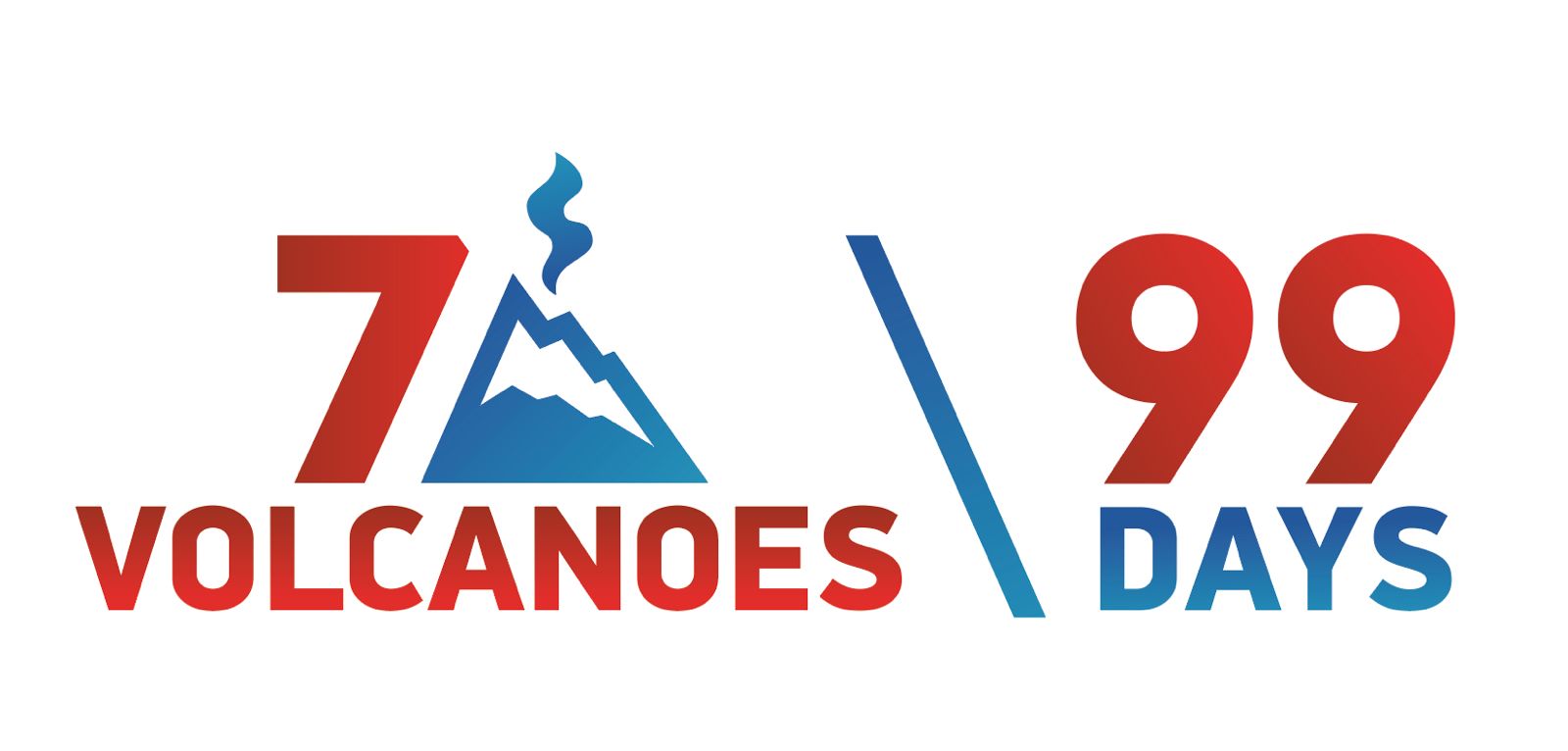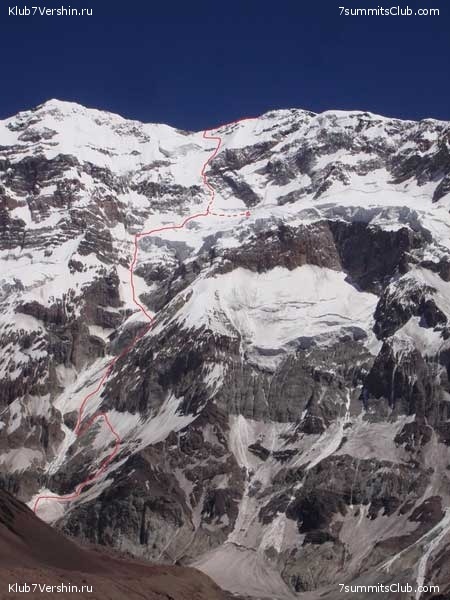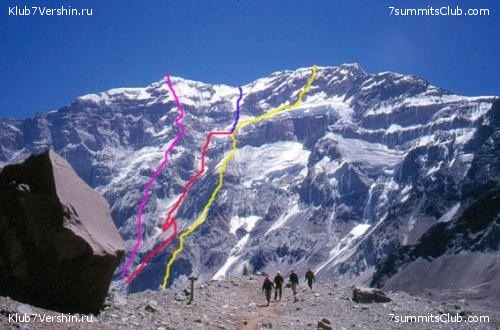Chad Kellogg: Solo New Route on Aconcagua South Face…
The line of Medicine Buddha (VI WI4 M4, 6,500'/1,980m of new ground) on the 3,000-meter south face of Aconcagua. Chad Kellogg joined the Messner Route and then the upper Argentinean Variation above the enormous serac band.
American Chad Kellogg has soloed a dangerous new line on the famed south face of Aconcagua (6,962 m).
Red line - route of Kellog, blue - exit variant of Messner
Kellogg traveled to Argentina with Rory Stark, aiming to acclimatize on the normal route on Aconcagua's north side and then attempt a line on the south face. Kellogg also wanted to try a one-day round trip on the normal route.
As planned, Kellogg summited via the normal route on December 17, but Stark was stricken with pneumonia high on the mountain. With the help of some fellow Americans, they descended all the way to base camp that day, but Stark remained severely ill and had to be helicoptered to town for treatment; he eventually returned to his home in Alaska and recovered.
On December 21, after repacking their gear and laying plans for a solo attempt on the south face, Kellogg hiked in to the base. A snowy winter and recent poor weather had plastered the face with ice and filled in crevasses, leaving it primed for a solo attempt. Kellogg scoped an unclimbed, avalanche-threatened line between the 1982 Slovenian Route to the left and the 1954 French Route (the original line on the face) on the right.
That afternoon, he hiked up to the foot of the face to check conditions. In an account of the climb that he wrote after returning, Kellogg said, “I was able to determine that the initial bergschrund was crossable and that the initial WI5+ pitch was flowing heavily with water and was best avoided. It seemed as though the majority of the climb was 65°-70° snow and ice, punctuated with vertical ice steps. The real difficulty lay in surviving the ice avalanches from the frequent serac falls. It was the summer solstice, after all, and the temps had really heated up. I walked away from the base, and minutes later a huge avalanche swept the route and avalanche cone where I had just been standing. I tried to steel my nerves against the possibility that I could be swept into that debris at the base from any point on the route within the next 6,500 vertical feet. I told myself that this was my route and in eight hours I would be on it.”
Kellogg hoped to complete the route in one long day, and he took minimal gear: a 30-meter, 8.1mm rope, about a dozen pieces of protection, and a stove and one fuel cartridge. He brought a few extra clothes and double boots for warmth, but no tent or sleeping bag. “I managed to rest for a few hours before I got up at 1:30 a.m.,” Kellogg wrote. “I centered myself with a meditation session before preparing for my departure.”
Leaving his camp at 4 a.m., Kellogg approached the face, crossing two large crevasses and the bergschrund. After climbing some snow slopes to bypass the steep, wet ice pitch at the base, he traversed left and then downclimbed and rappelled a couple of hundred feet to reach the central gully, where snow and ice patches allowed faster progress-a good thing because of the enormous serac bands that loomed thousands of feet overhead.
Several avalanches fell down the route as he climbed, but Kellogg escaped harm. Above a rock step and ice pitch, he reached a snow basin below the biggest serac band at ca. 6,000 meters. A very steep, short pitch of ice on the left side of the seracs gained the upper glacier. At this point Kellogg had climbed about 2,000 meters in 12 and a half hours and was on pace for a one-day ascent.
After a rest stop to brew a couple of liters of water, he traversed right to join the Messner Route (Reinhold Messner's 1974 solo direct variation to the French Route), still hoping to finish the climb that night. However, he soon encountered unconsolidated sugar snow and began wallowing. At 11 p.m., realizing he'd never make it to the top that night in such conditions, he downclimbed to the glacier and prepared for an open bivy.
Serac avalanche sweeps the lower gully where Kellogg had ascended. Photo by Chad Kellogg
Kellogg shivered for seven hours in temperatures he estimated at 10°F (-12°C). When the sun hit him in the morning, he continued upward, finding some better snow along with vertical ice and mixed passages on the upper Messner Route. By early afternoon he was within 400 meters of the summit ridge, but the snow conditions were very poor again. He had run out of water in midmorning, and he had no more fuel to melt snow As he continued upward, Kellogg's hands got soaked in the wet snow, and by evening he realized he had frostbite on his right thumb. He radioed rangers and told them he was near the ridge, and they encouraged him to keep moving and said they'd meet him at the Nido de Cóndores ranger station (at 5,300 meters) as he descended.
At 10 p.m., Kellogg reached the high ridgeline between Aconcagua's two summits. He had been on the face for 42 hours. In high winds, he struggled down the rocky ridge crest until he reached the Canaleta scree gully and joined the normal route. At 1:30 a.m., he made it down to the ranger station, where he finally could relax and get some hot drinks.
Kellogg called his new line Medicine Buddha (VI WI4 M4).
A few days later, on December 29, after recovering from his effort and getting treatment for his frostbitten thumb, Kellogg began an attempt on a one-day climb: a 50-mile round trip with 14,000 feet (4,275m) of elevation gain. He ran and climbed as far as Berlin Camp at 5,950 meters in 9 hours 15 minutes, but there he discovered that someone had broken into his gear cache and stolen the boots and equipment he needed for the summit. The speed attempt was over.
Dates of New Route Ascent: December 22-24, 2009
Sources: Chad Kellogg, American Alpine Journal






